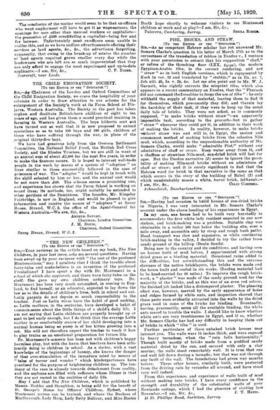[To THE EDITOR OF THE "SPECTATOR."] SIR,—Having had occasion to
build houses of sun-dried bricks in Nigeria, I was very interested in Mr. Somers Clarke's account under the above heading of his experiences in Egypt.
la my case, ene house had to be built very hurriedly to accommodate the first white lady resident expected in our new station, and brick-making was a problem. Suitable clay was obtainable in a valley 500 feet below the building site, over a mile away, and accessible only by steep and rough bush paths. Head transport was slow and expensive, so while continuing brick-making in the valley, I decided to try the rather loose sandy ground of the hilltop (Benin Sands).
Being new to the country and its conditions, and having seen no houses built of mud before, I experimented with strong dried grass as a binding material. Occasional mine added to the difficulties, but notwithstanding this and the extreme slowness of the native bricklayers, the bricks were made and the house built and roofed in six weeks. (Roofing material had to be head-carried for 66 miles.) To improve the rough brick- work, a " plaster " was made of the sandy ground used for the majority of the bricks, and as this was of an even red colour, the finished job looked like a distempered plaster. The pleasing effect was, however, marred by the early appearance of holes and ridges formed by white ants, and inspection showed that these pests were evidently attracted into the walls by the dried grass used in some of the bricks for binding. Eventually, having, presumably, eaten all the available binding, the white ants ceased to trouble the walls. I should like to know whether white ants are very troublesome in Egypt, and if so, whether Mr: Somers Clarke has had any difficulty in keeping theln out of bricks in which " tibn" is used.
Further particulars of these unbelted brick houses may
interest you. The walls were 14 inches thick, and were exposed to heavy tornadoes, when the "rain falls horizontally." Though built mostly of bricks made from a puddled sandy material dried by the Bun, and secured with only a clay mortar, -the walls stood remarkably well. It is true that one end wall fell down during a tornado; but that was not through any fault of the wall. The foundations had given way months before. Three other houses, similarly built, were protected from the driving rain by verandas all around, and have stood very well indeed.
From this experience, and experience of walls built of mud without making into bricks, I have every confidence in the strength and durability of the substitntial walls of your Newlands cottage, which I had the pleasure of visiting last










































 Previous page
Previous page